I should have known long ago that robins did this. That’s what happens when you too often ignore a species just because it’s “common”.
- Image techs for these photos range from: 1/400-1/640, f/5.6, ISO 800-1250, Canon 7D Mark II, Canon EF 500mm f/4L IS II USM + EF 1.4 III extender, not baited, set up or called in. All images are presented in the order they were taken.
Yesterday I spent some time in my back yard testing my lens and cameras. The only cooperative bird available was an American Robin sitting on my back fence but it was cloudy and the light was dim so after taking a few test shots of “him” (I don’t know its sex) I became interested enough in the bird that I simply watched him through my telephoto lens for over five minutes without taking any photos.
When his beak suddenly opened I instinctively fired off a short burst and the images below were what my camera caught (though my eye did not because in the beginning it happened too fast).
The bird brought something red up into the back of its throat…
and then held it in its beak for about two seconds.
But my eye didn’t see the object (I’m now sure it’s a seed) coming up in the back of the throat – this is the first view I noticed through my lens and it blew me away. I remember saying out loud to myself (verbatim)”Holy hell, did that bird just catch something falling (through the air) in its beak?”.
I still didn’t know what it was or where it came from when the bird dropped it. It can be seen falling at the edge of the frame at bottom, to the left of my broken rain gauge (it froze).
When another roundish-red object magically appeared in its bill I knew at that point it was regurgitating them and they were probably seeds of some kind.
The robin also dropped that seed.
Then it happened again…
And again. This time we can see his tongue pushing it out.
And again.
Then the robin hopped down from the fence, landed in my vegetable garden right in front of me and turned to look at me as if he was annoyed that I was aiming that big reflective “eye” at him.
As soon as I saw my images on my big screen and confirmed in my mind that the red objects were probably seeds I researched the behavior on the web. Here’s what Birds of North America Online has to say about the behavior in American Robins:
- “Frequently regurgitate seeds when eating fruits, especially if seeds are large, ridding themselves of indigestible seeds that would otherwise occupy gut space and reduce fruit handling times.”
I had wrongly assumed that seeds would just pass through the gut and be eliminated with the feces – after all, haven’t we all heard about seeds that won’t even sprout before they’ve passed through the gut of birds? That’s part of the reason that at first I thought the robin was somehow, almost as if by magic, catching those objects as they fell through the air. Looking back I’m embarrassed for even considering that possibility.
This is one of the two seeds I was able to retrieve from below the fence where the robin was perched. They’re slightly larger than a grain of rice, only fatter.
I have no idea which plant species it came from but I’ve now planted that seed and placed it in my plant window. Silly me, I’m not sure why I’ve planted it but I am curious about what will result if it sprouts. And my crazy-ass imagination even has visions of one day being able to photograph another robin perched on the resulting plant if it turns out to be a bush or small tree – wouldn’t that be fun!
I suspect that many readers already knew that robins regularly regurgitate seeds but it was news to me. Thanks for the lesson, Turdus migratorious !
Ron


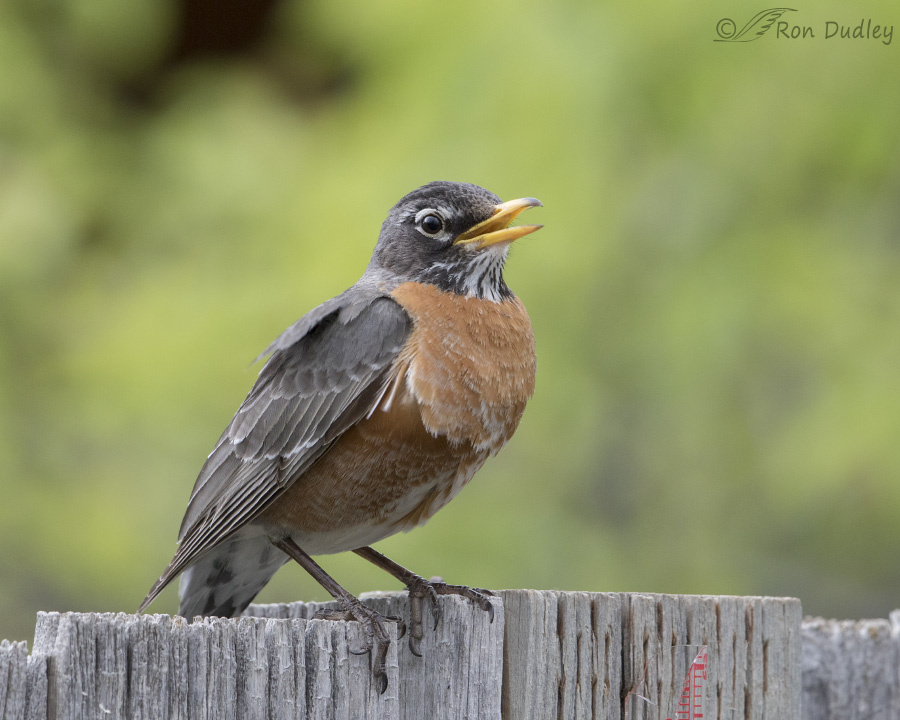
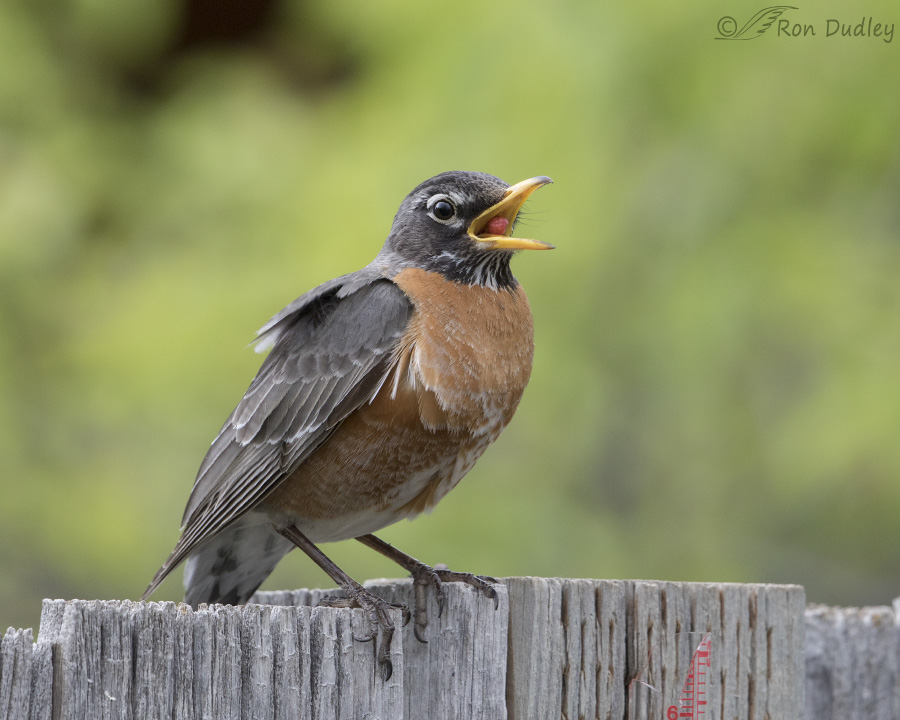
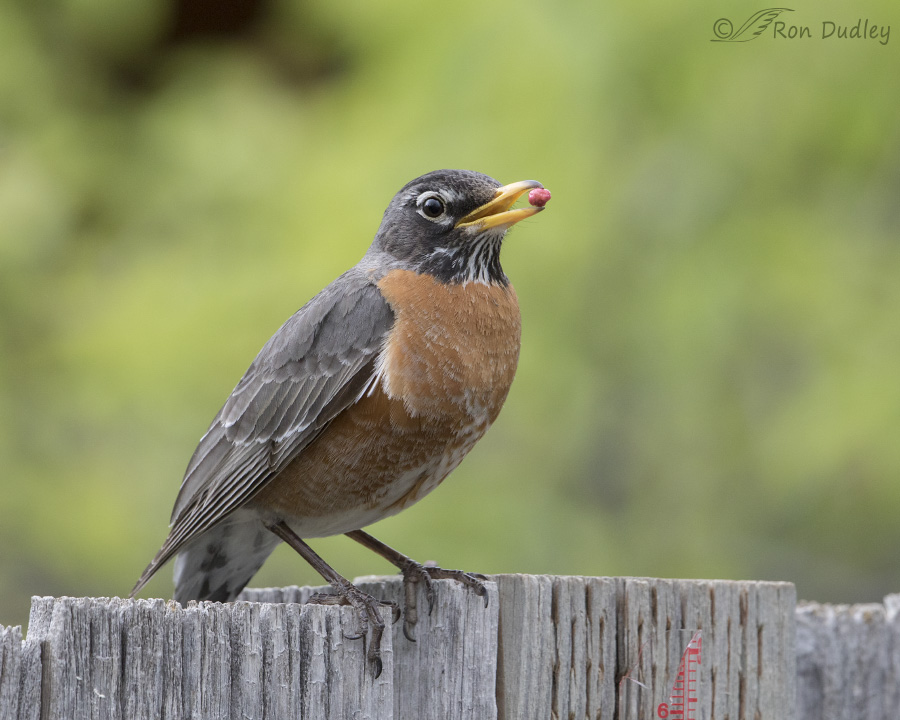
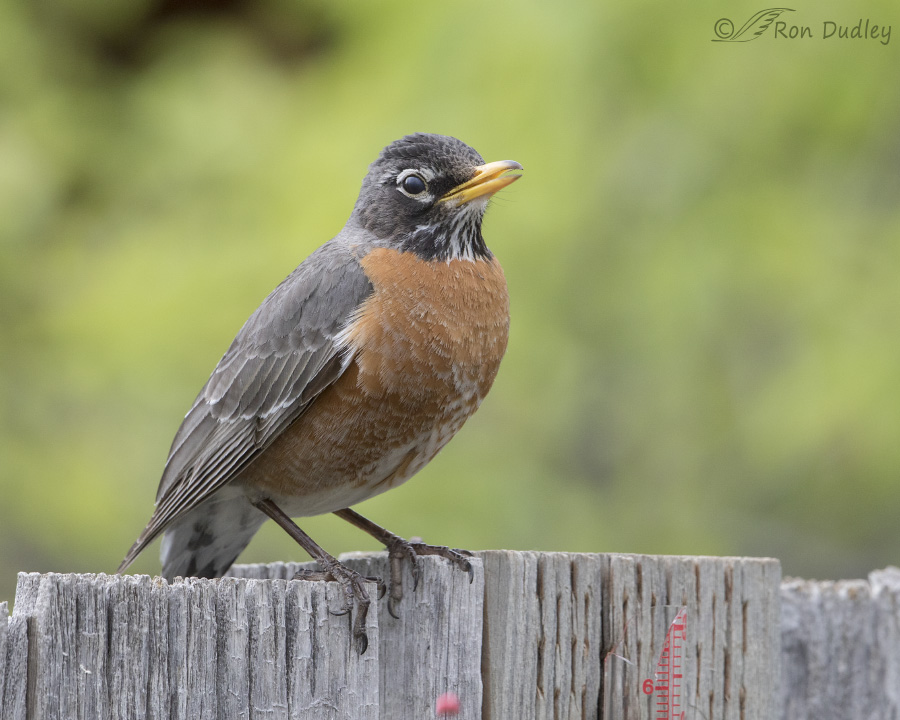
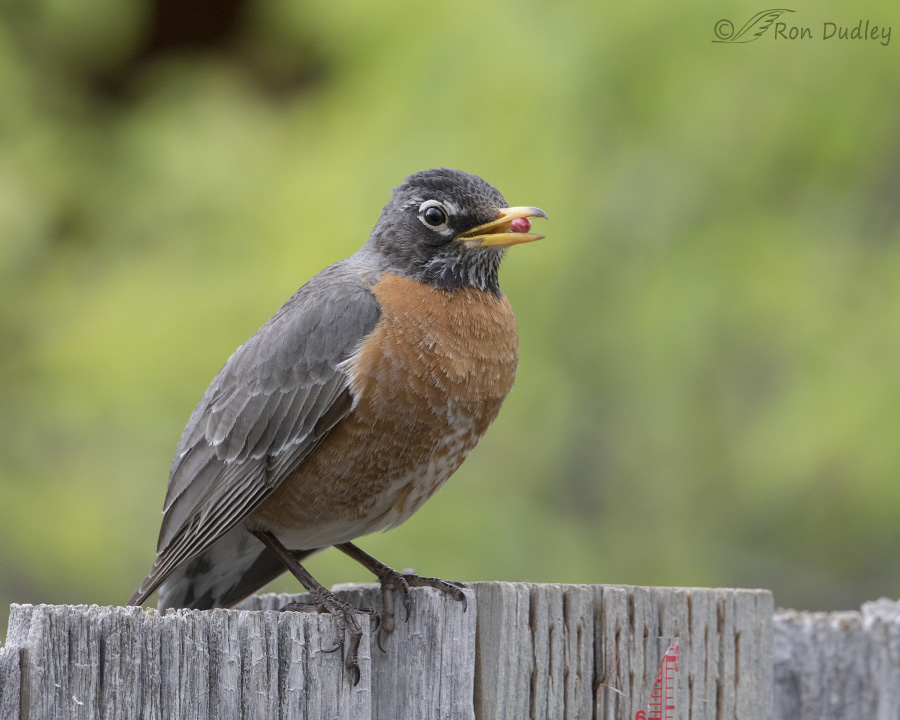
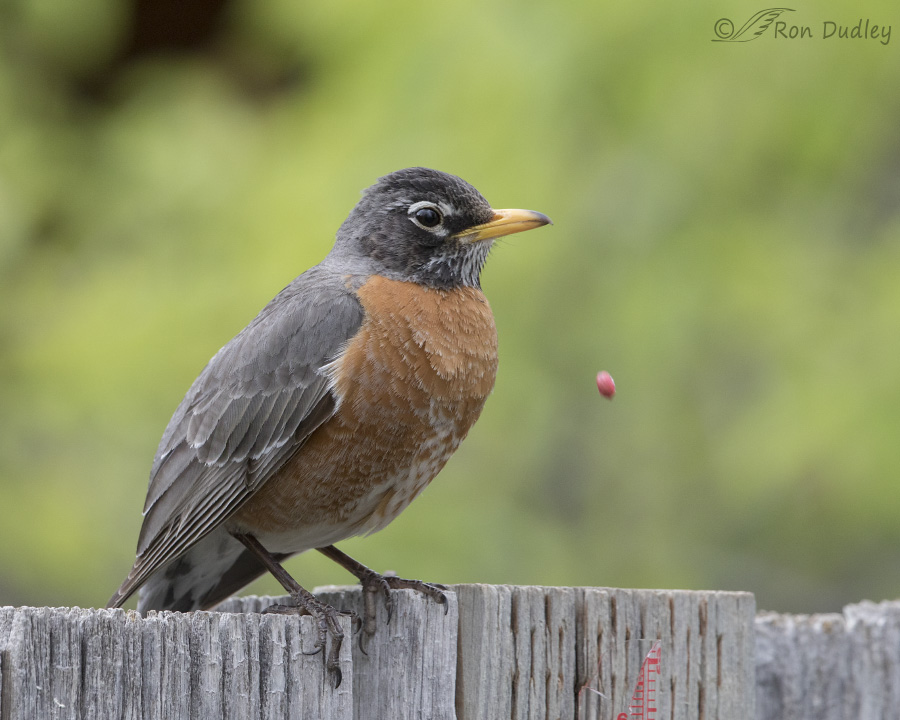
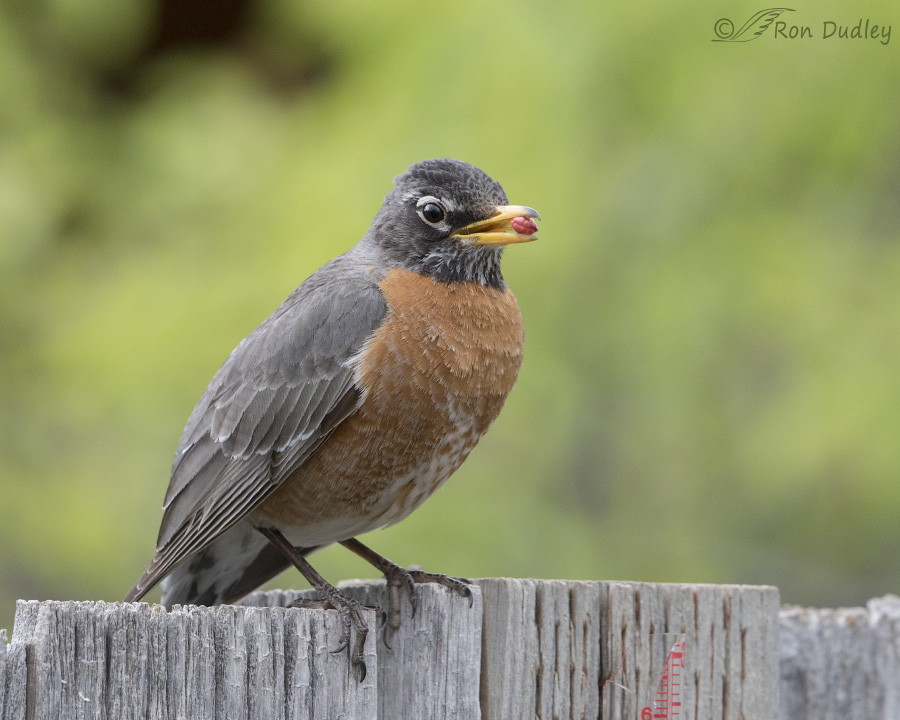
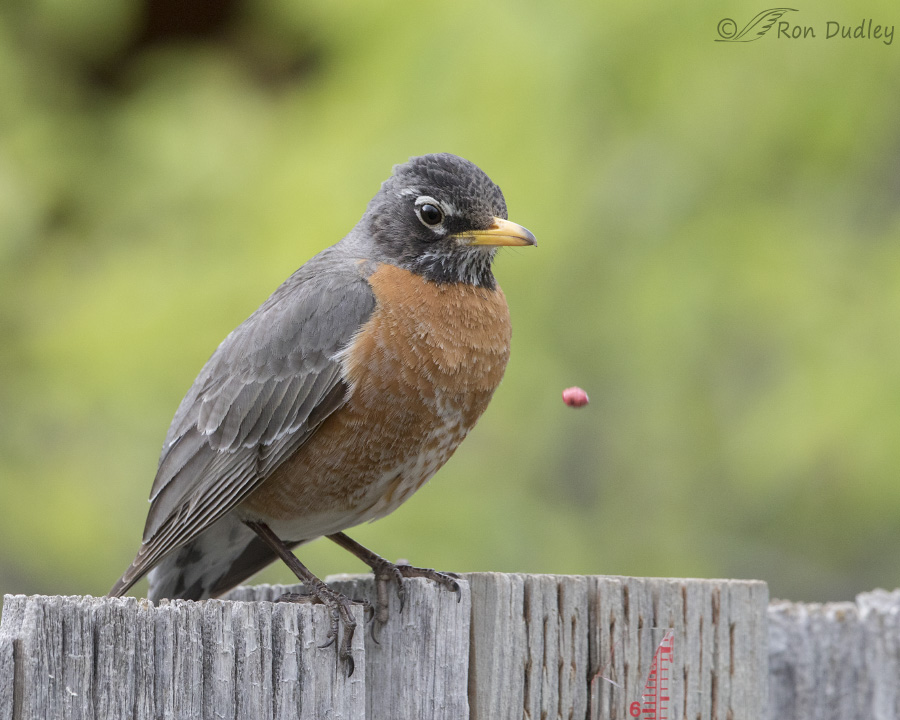
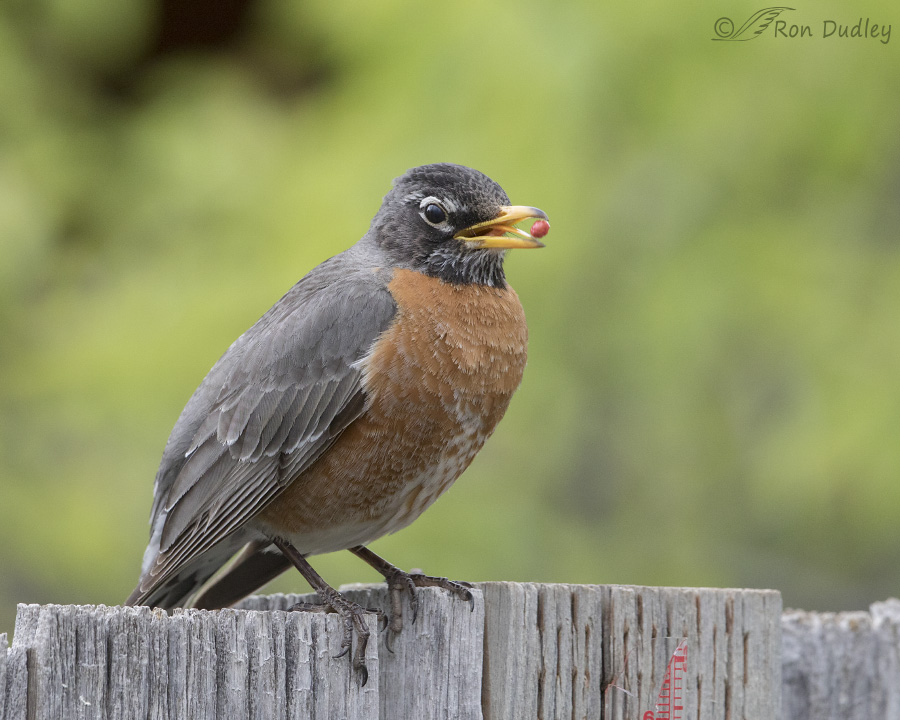
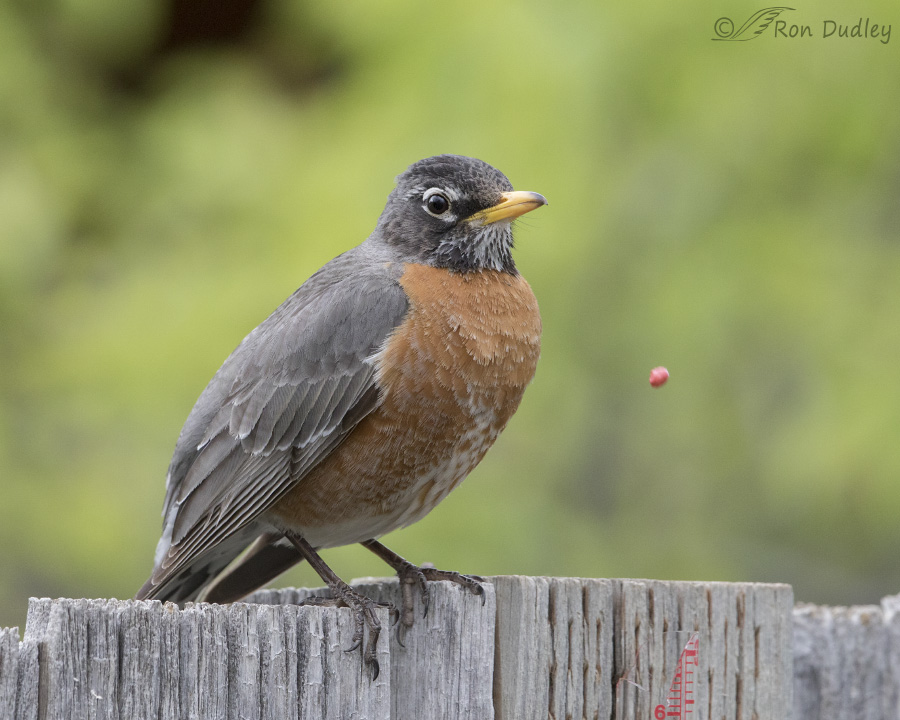
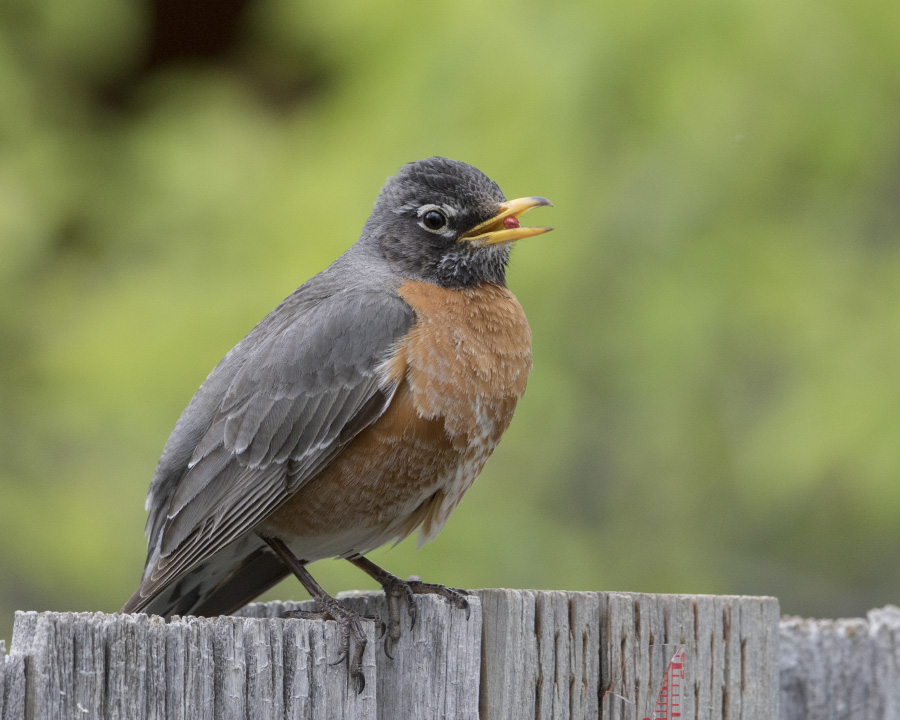
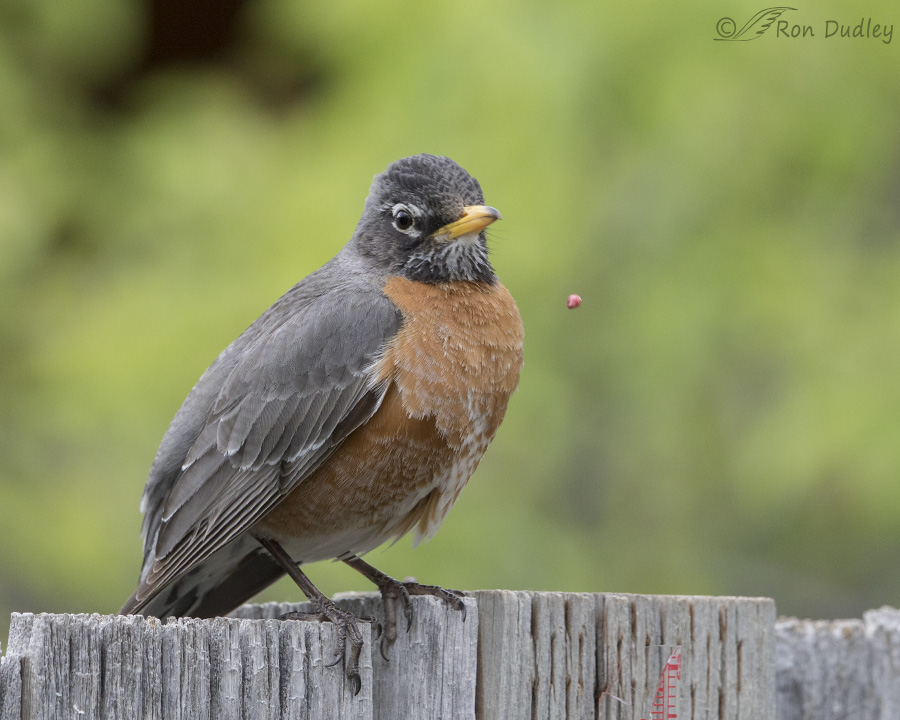
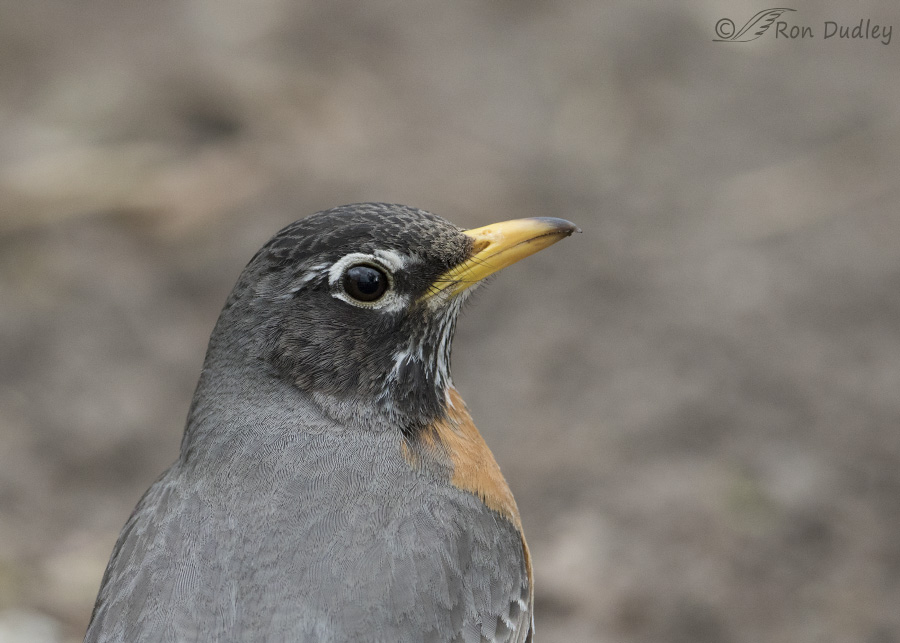
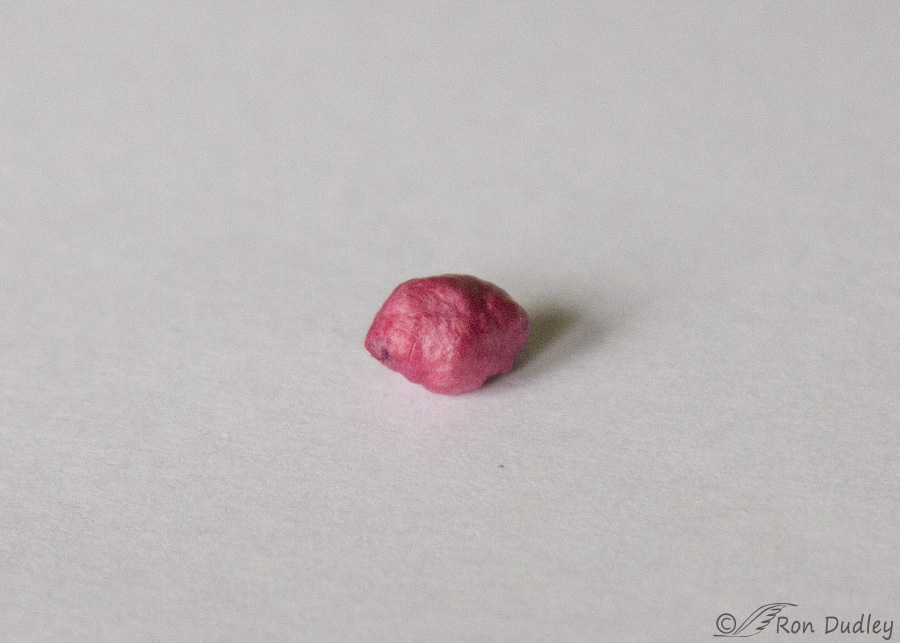

That’s quite a sequence of shots you’ve shared! But I can see my husband doing the same thing with the seed – planting it to see what happens and hoping that it keeps the robins happy. Lucky robins.
We have robins in our area of Ontario and more increasingly. in winter. I have never seen this behavior and, like you, often they are the only bird around to break the boredom. Could this be Bittersweet (Celastrus scandens or Celatrus orbiculatus) seeds?
I just don’t know, Judy. My botany skills are sadly lacking.
Yes! I find them in my birdbath sometimes. I discovered the behavior the same way – just by watching for awhile.
Ron, great series! I love robins, and the surround sound of a mellifluous flock. I photographed a Northern Mockingbird doing this very thing last month with small, round, black objects. Like you, I wasn’t sure at first if they were seeds … or small berries, or something else indigestible. I’ve seen many birds regurgitate for various reasons, but not often this behavior.
Thank you, Ingrid.
From the coloration I would say it is a female, lighter breast and head. Perhaps the seeds are hard to digest if fed to offspring. She cast them off before heading back to the nest.
Yes, it’s probably a female and you may be right about the nest.
Great pictures! And fun post.
Visiting my grandma in MA I saw robins in her yard. And then in the mountains 100 miles east of here I’ve seen robins. Ever since I opened my eyes to the idea that they could be found here, I’ve been seeing them around.
Levi
Levi, I didn’t know until this morning when a Facebook follower told me that robins weren’t found in some areas of SoCal. In many areas they’re ubiquitous.
The common birds, like the lbjs are sadly neglected. And we are the losers.
And I have learned something today. Always a win.
Thank you.
Thanks, EC.
Great, informative series! And I love the final portrait!
Thank you, Joanne.
Yet another reason that I’m real careful about using the word “common.” It often carries the evil intent of blocking our primary objective of learning something new every day. People call redtails common. Mariah (female redtail hawk who has shared my life for the past 23 years or thereabout because I’m lousy about remembering these time things) taught me early on about that word! Redtails just aren’t common. They’re abundant or wide-ranging or plentiful, but not even a little bit common! Same goes for robins! I grew up knowing that when the robins returned to northern Ohio, all was well–spring was coming soon and we had survived another bleak winter. Their song beckoned the magic of renewal and hope for the future.
And no, I didn’t know that they cast away seeds, but it makes perfect sense now that I learned that new thing today! Thank you for today’s valuable lesson!
Thank you, Laura.
“Abundant”…so MUCH better than “common”..”.widespread” is better, too…let ‘s junk “common” and its negative taint….”frequently seen” is another option, though it bears the burden if being a tad longer (TWO words instead of one…mercy!)
Language is important. Using the right word is important, too. Many years ago now, a small group of gray (?) whales taught me that lesson along the Oregon coast. I saw a mother and child swimming close to shore with other members of the group swimming farther out, forming a protective semi-circle around the mother and child. What a spectacular sight that spawned an epiphany in my brain! It dawned on me right there that if I’d used the words cow and calf, I would necessarily be distancing them from my understanding simply by using those words that differentiated the mother and child as something apart from me. While I recognize the need for some differentiation in terms of species clarity, we also need to remember that we’re far more alike than we are different. We humans need to recognize that it is ALSO necessary to remove that barrier to our understanding if we’ve got ANY hope of co-existing with the other inhabitants of this silly spinning rock!
Oh and I neglected to mention that robins carry a special magic in my heart to this day. Their nesting/mating song is simply spectacular!
It goes without saying that everyone is free to avoid using the word “common” as applied to animals if they choose to do so. However I won’t be following suit, for reasons I’ve explained before in these discussions.
Ron, it’s always OK to disagree
I left out Tunkasila,Wakan Tanka…the great mystery…hos could I…it’s the secret to it all, the basis of everything….now you know…
Believing in magic is a good thing…it helps us get through some of the tougher times…but this is better than magic! ( I also believe in the Loch Ness monster, Big Foot, Santa Claus, the Tooth Fairy, the Easter bunny, ghosts, mermaids, garden fairies, trolls, the Boogey Man, various spirits and The United States Government)…not so sure about God, the Devil, angels or other higher powers, good or bad….so be it.
Great photos, Ron! So neat to see the seed in different stages of being regurgitated. I didn’t know robins did this either. I’m curious to find out what kind of plant the seed sprouts into.
Thank you, Myriam.
I’ve raised quite a few robins–when I couldn’t find a wild pair to adopt them (which they often will do), but never saw any of them do this–I don’t think I ever gave them anything with seeds in them,either…very interesting! Your record holds…However long I’ve been one of your followers, I have NEVER yet seen a single one of your blogs where I didn’t learn something new and interesting…even about critters I raised!!! Amazing!!! Thanks, again…
That means a lot given your experiences, Patty. Thank you.
“However long I’ve been one of your followers”
I just looked it up, Patty. You made your first comment on my blog on May 16, 2013 on this post:
“https://www.featheredphotography.com/blog/2013/01/27/a-guide-to-aging-bald-eagles/
Since then you’ve made a total of 2,782 comments. Thank you for your loyalty.
Holy Hannah!!! That means you have posted something I’ve found new and interesting AT LEAST 2,782 times!!!!!!!!!!!!!!! (Also indicates that I have a big mouth!)
Your comments bring a smile to my face and often a giggle to my heart.
Thanks for a great series. I knew of the behavior but I’ve never been fortunate enough to see it. For me, seeing something new about a common bird is more interesting than seeing a rare bird out of place. (I seldom chase rarities) So many things get overlooked because something is “common.” Each year I give my students a detailed description of a bird — an American Robin. I mention the split eye-ring, the white streaks in the throat, the white at the corners of the tail, etc. The one detail I leave out is the color of the breast. No one ever knows what bird I have described without consulting a guide and even then they usually don’t get it. Because a robin is common, and easy to identify, no one takes the time to study the small details. Yet, most birders would probably look for just these details if they were seeing an unkown bird. There’s a lot we miss simply because something is common.
“There’s a lot we miss simply because something is common”
That’s it exactly, Dan. I’m like you in that I rarely chase rarities – party because I detest crowds…
Ron, if you have a good garden store near you, someone there might be able to identify the seeds. Sometimes folks with real botanical knowledge work at those places. Wanting to know what it is would be driving me nuts!
Me too, Judy (and good idea). And when you consider that I was already nuts to start with I’m in pretty bad shape…
I’m obviously nuts, too and getting more so by the minute…until I know where those seeds came from…was hoping you’d plant thrm and find out….Great minds think aliker…even small, badly bent ones…
Very interesting! I had no idea! Keep us posted on the seed you planted.
Will do, Jane.
Wow! I knew they ate fruit but never thought about the seeds. It’s amazing to me, being familiar with raptors and other birds that regurgitate pellets of indigestible material, that this bird could regurgitate the seeds one at a time! Nature is endlessly fascinating.
Agreed, Louise. That makes me feel better to know that the behavior is also new to you.
Gee, Ron – maybe you’ll get a beanstalk!
Have to change my name to Jack if that happens…
Do you think it may be a pomegranate seed? Perhaps someone in the area has a pomegranate plant growing in a planter on a patio or deck? Great shots and I am so glad you planted the seed!
I wouldn’t rule pomegranate seed out, Sybby. Maybe someone’s using a cut one to feed birds…
Pomegranate seeds are white, so this probably isn’t pomegranate.
Even as fascinating as the behavioral observation was, I was captured by the detail of the coloring and patterns in the robin’s breast and shoulder/back feathers. Like everybody else, it seems that I’ve
never looked carefully at this bird because it’s so “common”……your display this morning showed me that it’s very beautiful when closely observed…….thanks !
I agree, Kris. I’ll be paying more attention to robins in the future.
I love your photos and am thrilled that you turned your lens to a bird that most of us see almost daily. Song birds are not considered dramatic but the detail revealed in your photos adds to our appreciation of each species that catches your attention. More please! (PS This lovely Robin seems to be a lady. The gentlemen have the distinctive deep reddish orange breast with their head and back almost black … at least in NC)
I think you’re right about the sex, Melanie. Thanks.
Melanie, I agree with your determination of sex. What I know is that the head on males is darker than the body, to the point of being almost black. Females have heads that match the body. I did most of my Robin study in Richmond, VA, but they seem to be the same everywhere I’ve seen them.
Of COURSE you planted the seed! Love it! As I was reading your post my first though was, “I hope he plants them,” and as usual, you never disappoint.
What a nifty behavioral series. Yay for that instinct of yours!
Thank you, Marty. You and I think alike.
I feel bad for you — I can be pretty distorted at times. Tee hee.
Not me! First thing I thought was a chokecherry pit, but not sure. I know they eat tons of them and the pits are large relative to the amount of fruit on them and I have noticed lots of the pits around in the fall mainly – wondered, but never thought too much about it. It will be exciting to see what it grow into. Great capture and observation.
First thing I thought was a chokecherry pit, but not sure. I know they eat tons of them and the pits are large relative to the amount of fruit on them and I have noticed lots of the pits around in the fall mainly – wondered, but never thought too much about it. It will be exciting to see what it grow into. Great capture and observation. 
Hmmm, are those chokecherry pits red, Judy?
BNA lists dozens of types of fruits that robins eat but I’m not enough of a botanist to recognize this seed, even though it’s fairly distinctive in color and shape.
No, they aren’t red so that rules them out plus this is more oval me thinks.
Really neat info, Ron! I had no idea! GReatshots, too.
Thank you, Nancy.
Wow! What an amazing series! What a great eye and skill you Have! I’ve never seen them eat anything but worms. I had no idea they ate anything with seeds. Icantwait to hear what you are growing.
Charlotte
I’ll let everyone know if it sprouts, Charlotte. Thank you.
Guilty!!!Had No idea!!!
Not a fruit pit? Got any trees that have fruit that have held over during the winter where the fruit has pits, seed, imbedded in the fruit?
Great shots as usual.
You see one doesn’t have to go far to get excellent bird behavior shots!! LOL!
I wondered if it was a small fruit pit too, Dick. I dunno… A neighbor has a cherry tree but that’s not it.
Thanks Ron. News to me too. Great series.
Thank you, Hank.
I never knew that about Robins. The ones that visit my yard just hop around listing to the ground for worms. I have lots of bird seed out there but they never touch it. Thanks Ron!
Nice to know that I’m not the only one, Debbie!
Ron, I love the lengths you go to investigate wildlife! This is fascinating–a terrific sequence. Right now I have an eye-level built Robin’s nest in the crook of an elm tree in my backyard. I have been watching the three hatchlings in fascination. So funny how early the baby birds learn to be very quiet and in synchronization close their mouths and sink their curious heads below the nest. The world of animals is endlessly fascinating! Thanks for posting this.
Sandy, the say that curiosity killed the cat and one day it may kill me but in the meantime I have fun with it and even learn some stuff… Thank you.